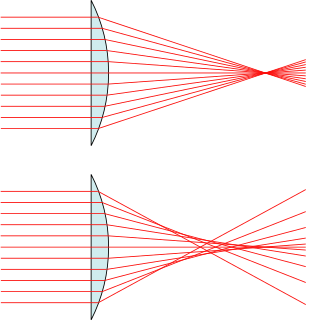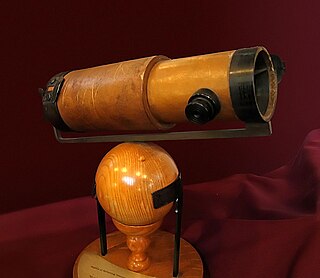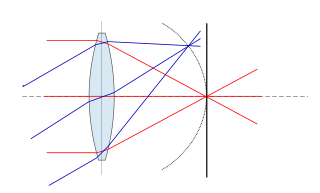Related Research Articles

In optics, chromatic aberration is a failure of a lens to focus all colors to the same point. It is caused by dispersion: the refractive index of the lens elements varies with the wavelength of light. The refractive index of most transparent materials decreases with increasing wavelength. Since the focal length of a lens depends on the refractive index, this variation in refractive index affects focusing. Chromatic aberration manifests itself as "fringes" of color along boundaries that separate dark and bright parts of the image.

A Ritchey–Chrétien telescope is a specialized variant of the Cassegrain telescope that has a hyperbolic primary mirror and a hyperbolic secondary mirror designed to eliminate off-axis optical errors (coma). The RCT has a wider field of view free of optical errors compared to a more traditional reflecting telescope configuration. Since the mid 20th century, a majority of large professional research telescopes have been Ritchey–Chrétien configurations; some well-known examples are the Hubble Space Telescope, the Keck telescopes and the ESO Very Large Telescope.

Spherical aberration is a type of aberration found in optical systems that use elements with spherical surfaces. Lenses and curved mirrors are most often made with surfaces that are spherical, because this shape is easier to form than non-spherical curved surfaces. Light rays that strike a spherical surface off-centre are refracted or reflected more or less than those that strike close to the centre. This deviation reduces the quality of images produced by optical systems.

Adaptive optics (AO) is a technology used to improve the performance of optical systems by reducing the effect of incoming wavefront distortions by deforming a mirror in order to compensate for the distortion. It is used in astronomical telescopes and laser communication systems to remove the effects of atmospheric distortion, in microscopy, optical fabrication and in retinal imaging systems to reduce optical aberrations. Adaptive optics works by measuring the distortions in a wavefront and compensating for them with a device that corrects those errors such as a deformable mirror or a liquid crystal array.

An optical telescope is a telescope that gathers and focuses light, mainly from the visible part of the electromagnetic spectrum, to create a magnified image for direct view, or to make a photograph, or to collect data through electronic image sensors.

A reflecting telescope is a telescope that uses a single or a combination of curved mirrors that reflect light and form an image. The reflecting telescope was invented in the 17th century, by Isaac Newton, as an alternative to the refracting telescope which, at that time, was a design that suffered from severe chromatic aberration. Although reflecting telescopes produce other types of optical aberrations, it is a design that allows for very large diameter objectives. Almost all of the major telescopes used in astronomy research are reflectors. Reflecting telescopes come in many design variations and may employ extra optical elements to improve image quality or place the image in a mechanically advantageous position. Since reflecting telescopes use mirrors, the design is sometimes referred to as a "catoptric" telescope.

The Newtonian telescope, also called the Newtonian reflector or just the Newtonian, is a type of reflecting telescope invented by the English scientist Sir Isaac Newton (1642–1727), using a concave primary mirror and a flat diagonal secondary mirror. Newton's first reflecting telescope was completed in 1668 and is the earliest known functional reflecting telescope. The Newtonian telescope's simple design makes it very popular with amateur telescope makers.

In optics, the coma, or comatic aberration, in an optical system refers to aberration inherent to certain optical designs or due to imperfection in the lens or other components that results in off-axis point sources such as stars appearing distorted, appearing to have a tail (coma) like a comet. Specifically, coma is defined as a variation in magnification over the entrance pupil. In refractive or diffractive optical systems, especially those imaging a wide spectral range, coma can be a function of wavelength, in which case it is a form of chromatic aberration.

In geometrical optics, a focus, also called an image point, is the point where light rays originating from a point on the object converge. Although the focus is conceptually a point, physically the focus has a spatial extent, called the blur circle. This non-ideal focusing may be caused by aberrations of the imaging optics. In the absence of significant aberrations, the smallest possible blur circle is the Airy disc, which is caused by diffraction from the optical system's aperture. Aberrations tend to get worse as the aperture diameter increases, while the Airy circle is smallest for large apertures.

A catadioptric optical system is one where refraction and reflection are combined in an optical system, usually via lenses (dioptrics) and curved mirrors (catoptrics). Catadioptric combinations are used in focusing systems such as searchlights, headlamps, early lighthouse focusing systems, optical telescopes, microscopes, and telephoto lenses. Other optical systems that use lenses and mirrors are also referred to as "catadioptric", such as surveillance catadioptric sensors.

The Maksutov is a catadioptric telescope design that combines a spherical mirror with a weakly negative meniscus lens in a design that takes advantage of all the surfaces being nearly "spherically symmetrical". The negative lens is usually full diameter and placed at the entrance pupil of the telescope. The design corrects the problems of off-axis aberrations such as coma found in reflecting telescopes while also correcting chromatic aberration. It was patented in 1941 by Russian optician Dmitri Dmitrievich Maksutov. Maksutov based his design on the idea behind the Schmidt camera of using the spherical errors of a negative lens to correct the opposite errors in a spherical primary mirror. The design is most commonly seen in a Cassegrain variation, with an integrated secondary, that can use all-spherical elements, thereby simplifying fabrication. Maksutov telescopes have been sold on the amateur market since the 1950s.

The Cassegrain reflector is a combination of a primary concave mirror and a secondary convex mirror, often used in optical telescopes and radio antennas, the main characteristic being that the optical path folds back onto itself, relative to the optical system's primary mirror entrance aperture. This design puts the focal point at a convenient location behind the primary mirror and the convex secondary adds a telephoto effect creating a much longer focal length in a mechanically short system.

Hyperspectral imaging, like other spectral imaging, collects and processes information from across the electromagnetic spectrum. The goal of hyperspectral imaging is to obtain the spectrum for each pixel in the image of a scene, with the purpose of finding objects, identifying materials, or detecting processes. There are three general branches of spectral imagers. There are push broom scanners and the related whisk broom scanners, which read images over time, band sequential scanners, which acquire images of an area at different wavelengths, and snapshot hyperspectral imaging, which uses a staring array to generate an image in an instant.
In Gaussian optics, the cardinal points consist of three pairs of points located on the optical axis of a rotationally symmetric, focal, optical system. These are the focal points, the principal points, and the nodal points. For ideal systems, the basic imaging properties such as image size, location, and orientation are completely determined by the locations of the cardinal points; in fact only four points are necessary: the focal points and either the principal or nodal points. The only ideal system that has been achieved in practice is the plane mirror, however the cardinal points are widely used to approximate the behavior of real optical systems. Cardinal points provide a way to analytically simplify a system with many components, allowing the imaging characteristics of the system to be approximately determined with simple calculations.

In optics, a Mangin mirror is a negative meniscus lens with the reflective surface on the rear side of the glass forming a curved mirror that reflects light without spherical aberration. This reflector was invented in 1876 by a French officer Alphonse Mangin as an improved catadioptric reflector for search lights and is also used in other optical devices.

Petzval field curvature, named for Joseph Petzval, describes the optical aberration in which a flat object normal to the optical axis cannot be brought properly into focus on a flat image plane.

The NIRSpec is one of the four scientific instruments which will be flown on the James Webb Space Telescope (JWST). The JWST is the follow-on mission to the Hubble Space Telescope (HST) and is developed to receive more information about the origins of the universe by observing infrared light from the first stars and galaxies. In comparison to HST, its instruments will allow looking further back in time and will study the so-called Dark Ages during which the universe was opaque, about 150 to 800 million years after the Big Bang.

The 3.6m Devasthal Optical Telescope is a clear-aperture Ritchey–Chrétien telescope built by Aryabhatta Research Institute of Observational Sciences (ARIES) and is located at the Devasthal Observatory site near Nainital, India. ARIES operates another 1.3m telescope at the same location. The telescope was activated remotely on 31 March 2016 by Indian Prime Minister Narendra Modi and Belgian Prime Minister Charles Michel from Brussels. The telescope optics has been built in collaboration with the Belgian firm Advanced Mechanical & Optical System (AMOS).

Optical Telescope Element (OTE) is a sub-section of the James Webb Space Telescope, a large infrared space telescope scheduled to be launched early 2021. The OTE consists of some major parts of the telescopes including the main mirror, the secondary mirrors, the framework and controls to support those mirrors, and various thermal and other systems to support the functioning of the telescope. The other two major sections of the JWST are the Integrated Science Instrument Module (ISIM) and the Spacecraft Element (SE), which includes the Spacecraft Bus and Sunshield. The OTE collects the light and sends it to the science instruments in the ISIM. The OTE has been compared to being the "eye" of the telescope and the backplane of it to being the "spine".
References
![]()
- ↑ Bazhanov, Y. V.; Vlahko, V. B. (2012-09-17). "Design of an off-axis optical reflecting system". 8444. doi:10.1117/12.926162.short.Cite journal requires
|journal=(help) - ↑ Bazhanov, Y. V.; Vlahko, V. B. (2012-09-17). "Design of an off-axis optical reflecting system". 8444. doi:10.1117/12.926162.short.Cite journal requires
|journal=(help) - ↑ Kim, Youngsoo; Hong, Jinsuk; Choi, Byeongin; Kim, Yeonsoo (2018-05-08). "Three mirror off-axis optical system with an obscuration hole as a fore optics of the hyperspectral imager". 10644. doi:10.1117/12.2284765.short.Cite journal requires
|journal=(help)
| This optics-related article is a stub. You can help Wikipedia by expanding it. |